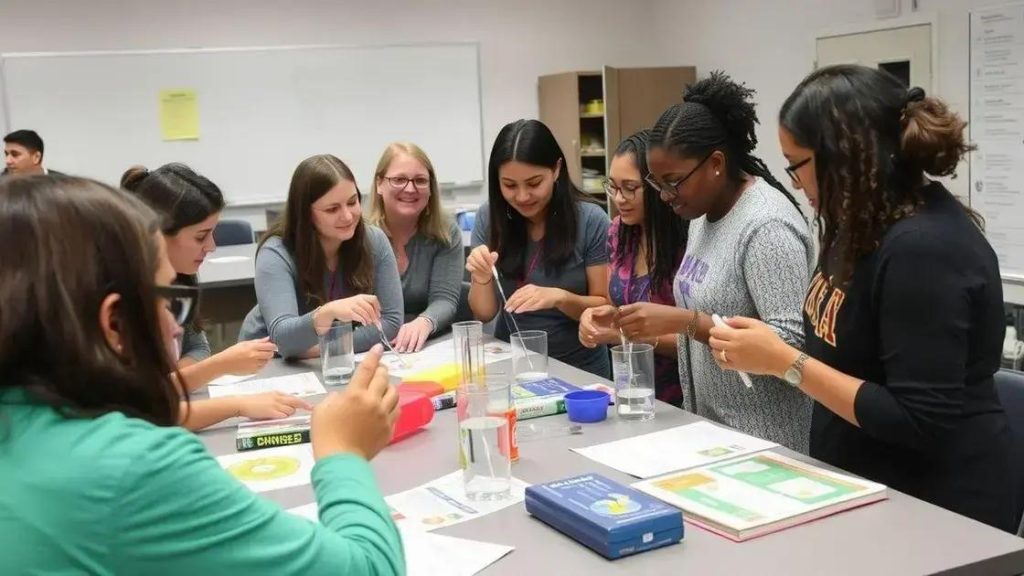Federal funding for STEM teacher training: unlock new opportunities

Federal funding for STEM teacher training enhances educators’ skills, improves student engagement, and prepares future generations for careers in science, technology, engineering, and mathematics.
Federal funding for STEM teacher training plays a crucial role in equipping educators with the tools they need. Have you ever wondered how this funding shapes the future of education? Let’s dive into its significance and benefits.
Understanding federal funding mechanisms
Understanding federal funding mechanisms is essential for educators who want to enhance their teaching through innovative programs. This knowledge enables teachers to effectively navigate the landscape of financial support available for STEM initiatives.
Various funding sources can significantly impact the quality of STEM education. The federal government often allocates money for specific programs aimed at improving education and training. This funding is typically distributed through grants, which can be competitive or formula-based.
Types of Federal Funding
There are several types of federal funding that educators should be aware of:
- Competitive Grants: These grants require schools to submit proposals demonstrating how they plan to use the funds to improve their STEM programs.
- Formula Grants: These grants are allocated based on a formula that considers various demographic factors, such as student population.
- Cooperative Agreements: In these cases, the federal agency partners with schools to implement specific educational projects.
In addition to grants, funding may also come from federal programs that specifically target teacher training in STEM subjects. Programs such as the National Science Foundation (NSF) offer resources and workshops aimed at teacher development.
Understanding how to access and utilize these funding opportunities is crucial. Educators should familiarize themselves with application processes and eligibility requirements. This knowledge not only empowers teachers but also enhances the overall learning experience for students.
By grasping the basics of federal funding mechanisms, educators can take the first step toward securing supportive resources for their classrooms. Such funding can make a significant difference in cultivating a strong foundation in STEM education, thereby inspiring the next generation of innovators.
The impact of STEM teacher training
The impact of STEM teacher training is profound and far-reaching. When educators receive proper training in STEM subjects, they are better equipped to inspire their students. This training enables teachers to bring innovative techniques into the classroom, sparking student interest in critical areas of science, technology, engineering, and mathematics.
Quality STEM training can enhance teaching effectiveness. Teachers who are knowledgeable about current STEM trends can provide students with the skills needed for future careers. Students with trained teachers are more likely to engage in hands-on projects and collaborative learning experiences.
Benefits of Effective Training
Effective STEM teacher training offers several key benefits:
- Improved Student Outcomes: Training increases student engagement and understanding, leading to better grades and test scores.
- Enhanced Teacher Confidence: With proper training, teachers feel more capable of delivering complex material and aiding student learning.
- Collaboration Opportunities: Trained teachers can collaborate on projects, sharing best practices and fostering a community of learning.
Moreover, when teachers are invested in their professional development, it sets a positive example for their students. A culture of continuous learning emerges within the school, encouraging students to value education and pursue STEM fields.
Research shows that schools with trained STEM educators often see a rise in student interest in pursuing STEM careers. This aligns with the national agenda to increase the number of students entering STEM professions, ensuring a well-prepared workforce for the future.
Strategies to apply for funding

Applying for federal funding can seem daunting, but having clear strategies to apply for funding can simplify the process. Understanding the steps involved and knowing where to look for information can increase your chances of securing financial support for STEM programs.
One effective approach is to thoroughly research available grants. Many federal agencies provide detailed descriptions of their funding opportunities. Reading these guidelines carefully ensures that your application aligns with the agency’s goals. This alignment is crucial for a successful proposal.
Key Steps to Consider
Here are some important strategies to keep in mind when applying for funding:
- Identify Funding Opportunities: Use online databases and federal websites to find grants related to STEM education.
- Understand Eligibility Requirements: Make sure you meet all criteria before starting your application.
- Develop a Strong Proposal: Clearly outline your project, demonstrating its importance and potential impact on STEM education.
Another important aspect is networking. Connecting with other educators or institutions that have successfully received funding can provide valuable insights. They can share their experiences and advice on crafting successful applications.
Utilizing workshops and training sessions offered by educational organizations is also beneficial. These sessions often provide guidance on writing proposals and understanding the funding landscape. Engaging in these opportunities can enhance your understanding of what funders are looking for.
Lastly, don’t hesitate to seek feedback on your application before submission. Colleagues or mentors can offer constructive criticism that improves your proposal quality. Incorporating their suggestions can make a significant difference in how your application is perceived.
Success stories in STEM education
Success stories in STEM education showcase the transformative power of effective teaching and innovative programs. These narratives inspire educators and highlight the potential that proper funding and training can unleash in students.
One remarkable example is a school district that implemented hands-on STEM initiatives. With the help of federal funding, they created a program that integrates technology into the classroom. Students engaged in real-world projects, inspiring excitement and curiosity about science and mathematics.
Examples of Impactful Programs
Here are some notable success stories:
- Project Lead the Way: This program has helped thousands of students develop critical thinking and problem-solving skills through project-based learning in STEM fields.
- Robotics Competitions: Schools participating in robotics competitions report not only improved student engagement but also higher interest in pursuing careers in engineering and technology.
- STEM Summer Camps: Many school districts run summer camps focused on STEM education. These camps allow students to explore different STEM fields, fostering passion and creativity.
These programs demonstrate that when educators have access to the right resources and support, incredible outcomes are possible. Stories like these can motivate other schools to seek funding and adopt similar initiatives.
Moreover, sharing these successes helps create a community of educators who can learn from each other. Networking through conferences, online forums, and collaborative projects can further amplify the positive impact of STEM education.
Future trends in STEM teacher training
Future trends in STEM teacher training indicate a shift towards more innovative and flexible educational approaches. As technology continues to advance, so do the methods educators use to train future teachers. Online courses and blended learning models are becoming more common, making it easier for teachers to participate in professional development.
Moreover, a focus on practical experience is growing. Teacher training programs are increasingly incorporating fieldwork and internships, allowing trainees to gain hands-on experience in real classroom settings. This practical approach helps aspiring teachers feel more prepared for their careers.
Emerging Techniques in Training
Several key trends are shaping the future of STEM teacher training:
- Use of Technology: Virtual reality (VR) and augmented reality (AR) are being integrated into training programs. These technologies offer immersive experiences that enhance learning.
- Collaboration with Industry: Partnerships with tech companies and universities are helping educators stay updated on the latest advancements in STEM fields.
- Personalized Learning: Training programs are beginning to offer more personalized pathways, allowing teachers to focus on areas they are most passionate about or where they need the most growth.
Additionally, a greater emphasis on diversity and inclusion is becoming prominent. Programs that reflect diverse backgrounds and perspectives prepare educators to teach a diverse student body effectively. This ensures that all students feel represented and included in STEM education.
As these trends continue to evolve, it’s important for educational institutions to adapt their training programs. Preparing teachers to navigate these changes will ultimately benefit students and enhance the quality of STEM education across the board.
FAQ – Frequently Asked Questions about Federal Funding for STEM Teacher Training
What is federal funding for STEM teacher training?
Federal funding for STEM teacher training refers to financial support provided by the government to enhance the skills of teachers in science, technology, engineering, and mathematics.
How can I apply for federal funding?
You can apply for federal funding by researching available grants, understanding eligibility, and submitting a detailed proposal that aligns with the funding agency’s goals.
What are the benefits of STEM teacher training?
STEM teacher training improves teaching effectiveness, increases student engagement, and helps prepare students for future careers in STEM fields.
What future trends are shaping STEM teacher training?
Future trends include the use of technology in training, personalized learning pathways, and a focus on collaboration with industry partners.





